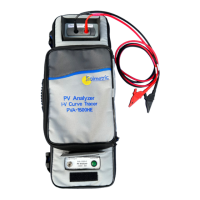Software Overview
3-73
Table 15. Description of the Model Details section of the exported csv file
The value of irradiance used in the predictive model.
Cell temperature used in
model
The value of PV cell temperature used in the predictive
model.
The value of array tilt used in the predictive model.
The compass direction the array is facing. 0=N, 90=E,
180=S, 270=W.
The resistance of the conductors between the point of
measurement and the PV source (typically the home run
conductors), calculated from the wiring details entered by
the user when the Project was created.
The ratio of measured to predicted maximum power,
expressed in %
The location on Earth where the measurement was made.
The time zone in which the measurement was made.
Manufacturer of the PV module
Model number of the PV module
Number of modules connected measured in series.
Number of strings measured in parallel.
Wire gauge of the conductors between the point of
measurement and the PV source.
Length (one-way, in ft) of the conductors between the
point of measurement and the PV source.
Figure 46 shows the voltage, current, and power data saved from the measurement. The number of
entries depends on the I-V curve resolution selected by the user for this particular measurement (default
100 points, user settable to 500 points).
The saved data array does not include the final values of Isc or Voc. The PV model calculates Isc by
projecting the first current point onto the vertical (current) axis of the I-V graph. The uncertainty
introduced by this step is minimal. The final value of Voc is measured a split second before the start of
the I-V curve sweep, using a separate, internal high-impedance voltmeter. This assures that the PV
source circuit is truly unloaded when Voc is measured.

